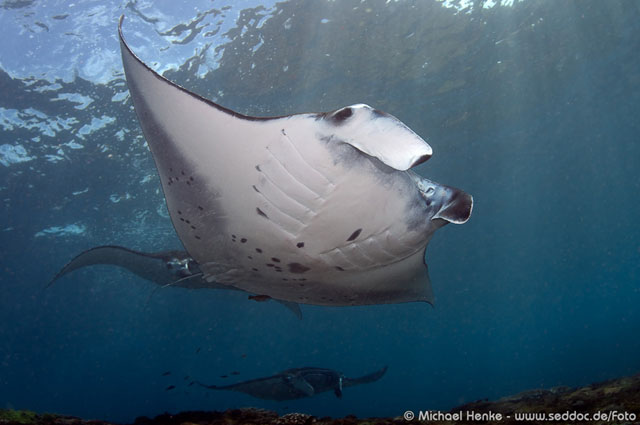| Mobulidae (Devilrays) |
| 500 cm WD (male/unsexed); max. reported age: 31 years |
|
benthopelagic; marine; depth range 0 - 120 m |
| Indo-West Pacific: Red Sea, South Africa, Thailand to Western Australia.; north to Japan (Yaeyama Is.), to Solitary Is., Australia as far east as French Polynesia and the Hawaiian Is. Reported in the Atlantic (Canary and Cape Verde islands) but this species may be restricted more or less to the Indian and Western Pacific only (McEachran, pers.comm. 03/10). |
|
This species is characterized by the following: disc approximately 2.2-2.4 times as broad as it is long, the maximum disc width size approximately 550 cm; slender whip-like tail approximately 123% of disc length if intact; no distinct caudal spine or cartilaginous mass at base of tail; some specimens have small hump at the base of the tail on the dorsal surface, while others have a slight depression and groove on the dorsum of the tail immediately posterior to the posterior margin of the dorsal fin; small, knob-like dermal denticles evenly distributed on both the dorsal and ventral surfaces, with ventral surface having slightly larger denticles; dental ligament with small cusped teeth on the lower jaw measuring roughly 22% of total disc length, approximately 6-8 rows, 142-182 files across entire width of the tooth band; total tooth counts of 900-1500 for entire tooth band; top jaw lacks rows of enlarged denticles (Ref. 82755). |
| Adults are commonly sighted inshore, within a few kilometers of land; found around coral and rocky reefs as well as along productive coastlines with consistent upwelling, tropical island groups, atolls and bays (Ref. 82755). Maximum movement recorded is >500,000 m (Ref. 97317). Known aggregations include sites in Hawai'i, Mozambique, Maldives, Ryukyu Island, Yap Island, Indonesia, eastern and western Australia (Ref. 82755). Gestation period is 12-13 months. Major food consists of planktonic organisms and probably small bony fishes (Ref. 114953). |
|
Vulnerable (VU); Date assessed: 09 November 2018 (A2bcd+3d) Ref. (130435)
|
| harmless |
Source and more info: www.fishbase.org. For personal, classroom, and other internal use only. Not for publication.
